For centuries, man has minted precious gold testimonies, full of history, power and beauty. Some of these, born for exchanges between empires or to celebrate sovereigns and nations, are today sought after throughout the world.
Unlike the more common ingots, bars or plaques, each specimen contains the cultural identity of its time and reflects the evolution of coinage. Investors and collectors consider them eternal symbols of stability and prestige. I present to you the ones that are the most known and traded, in my order of preference.
Contents
- Sovereign (Great Britain)
- American Eagle (U.S.A.)
- Britannia (Great Britain)
- Krugerrand (South Africa)
- 50 Pesos (Mexico)
- Marengo (Multinational)
- Maple Leaf (Canada)
- Kangaroo (Australia)
- 4 Ducats (Austria)
#1. Sovereign (Great Britain)
The British Sovereign was created in 1817 during the monetary reform desired by King George III, to create a stable and universal gold coin within the Empire. Its nominal value was one pound, but its true value lay in its gold content and international trust. It was entrusted to the art of the Italian engraver Benedetto Pistrucci, who sculpted the iconic scene of St. George slaying the dragon. For over a century, the Sovereign circulated in many colonies, becoming a symbol of British imperial power. It is still minted today both as an investment and as a collector’s item.
Fun fact: in the 19th century it was customary to sew a Sovereign into clothing as a “gold reserve” in case of emergency or escape. It was one of the most counterfeited coins in European history. Some historical editions were also minted outside the United Kingdom, in mints of the Empire such as Sydney, Ottawa, Pretoria and Bombay.
It is nicknamed simply Sovereign in the Anglo-Saxon world, or Gold Pound in Italy. In colloquial context it is sometimes called “Sovrana” among collectors.
Among the most popular alternative denominations are the Half Sovereign, the Double Sovereign and, in recent times, also the Quarter Sovereign and the Quintuple Sovereign, minted by the Royal Mint for collecting and investment purposes.
| Mass of Pure Gold | Diameter | Thickness |
|---|---|---|
| 7.32 g | 22.05 mm | 1.52 mm |

#2. American Eagle (U.S.A.)
The American Eagle was born in 1986 as an official response from the United States to the growing global interest in investment gold. The American government, through the federal mint (United States Mint), decided to mint a gold coin guaranteed by the State, both for content and value. The design chosen for the obverse is the historic figure of Liberty walking, created by Augustus Saint-Gaudens in 1907. On the reverse, an eagle in flight was initially depicted, then updated in 2021 with an eagle in the foreground. It is available every year in different denominations and continues to be very popular among investors.
A peculiarity of the American Eagle is that it is not made of pure gold, but composed of an alloy of gold, copper and silver: this makes it more resistant to wear. It is one of the few investment coins with legal tender value ($50 per ounce), although in practice it is worth much more. It also exists in proof and platinum versions.
It is commonly called American Eagle or Gold Eagle. Among collectors it is also used simply Eagle, while in Italy it is sometimes called Aquila Americana.
Among the most popular alternative cuts are the 1/2 ounce, 1/4 ounce, and 1/10 ounce versions, all with the same design and alloy.
| Mass of Pure Gold | Diameter | Thickness |
|---|---|---|
| 31.10 g (1 ozt) | 32.7 mm | 2.87 mm |
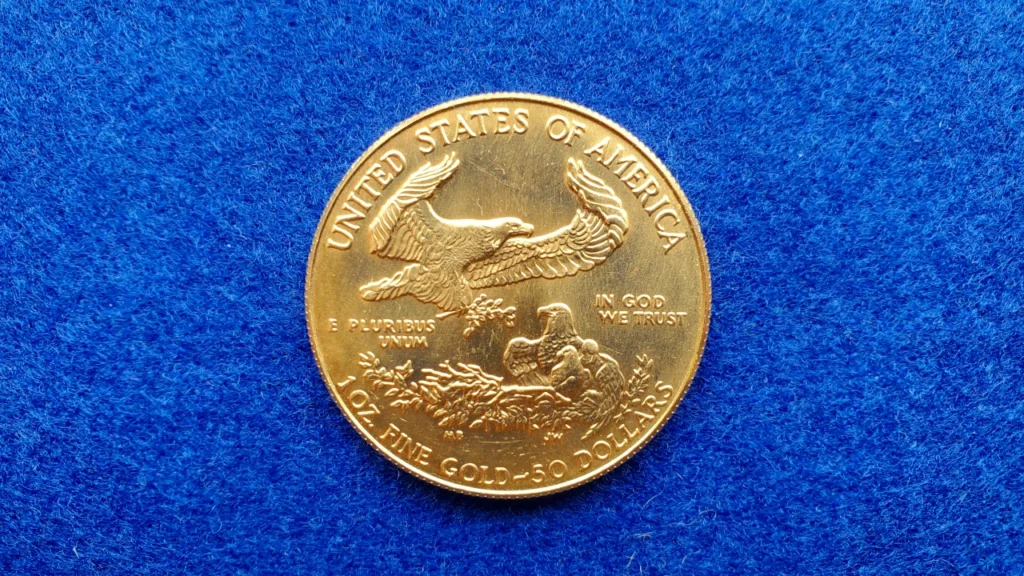
#3. Britannia (Great Britain)
The Britannia was introduced in 1987 by the United Kingdom as its official gold bullion coin. Its creation responded to the growing popularity of global bullion coins such as the Krugerrand and the American Eagle. The design features the allegorical figure of Britannia, a symbol of national strength and unity, armed with a shield, helmet and trident. Over time it has undergone various graphic and security updates, while maintaining its classic style intact. It is issued annually by the Royal Mint and is internationally recognised.
Fun fact: since 2013, the Britannia has been made of pure gold (999.9), while the first editions were in 22-carat gold. It has adopted advanced anti-counterfeiting techniques, such as wave patterns and micro-engraved details. It also exists in silver and platinum versions.
She is known simply as Britannia. She has no real nicknames, but in informal circles she can be heard called Gold Britannia.
Alternative denominations include 1/2 ounce, 1/4 ounce, 1/10 ounce, and 1/20 ounce fractional versions, all identical in style but with different weights.
| Mass of Pure Gold | Diameter | Thickness |
|---|---|---|
| 31.10 g (1 ozt) | 32.69 mm | 2.38 mm |
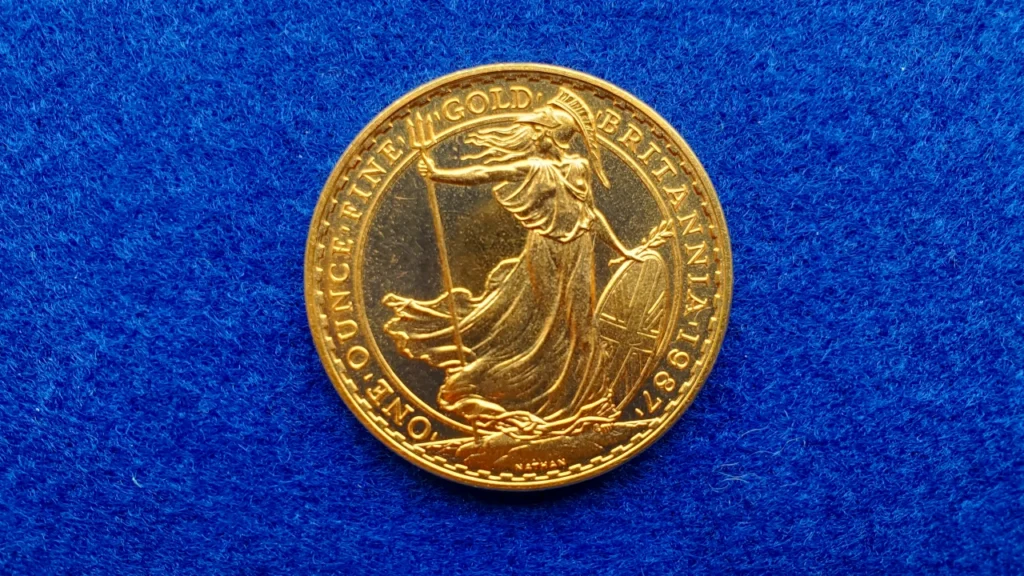
#4. Krugerrand (South Africa)
The Krugerrand was created in 1967 in South Africa as the first gold investment coin intended for the international market. It was designed to facilitate the ownership and trade of gold among private individuals, at a time when gold was still highly regulated. Its name combines that of Paul Kruger, president of the Transvaal Republic, and the word “rand”, the South African currency. The obverse features Kruger’s profile, while the reverse features a springbok antelope, the national symbol. For many years, it was the most popular gold investment coin in the world.
A peculiarity of the Krugerrand is that it contains an alloy of gold and copper: despite the total weight being more than one ounce, the quantity of pure gold remains exactly 31.10 g. This makes it more resistant to scratches and with a slightly reddish color. It was banned in some countries during apartheid, but has always maintained a strong market.
He is known simply as Krugerrand. No real nickname, although he is sometimes informally called “the South African.”
The most popular alternative denominations are the 1/2 ounce, 1/4 ounce, and 1/10 ounce fractional versions, introduced starting in the 1980s.
| Mass of Pure Gold | Diameter | Thickness |
|---|---|---|
| 31.10 g (1 ozt) | 32.77 mm | 2.84 mm |
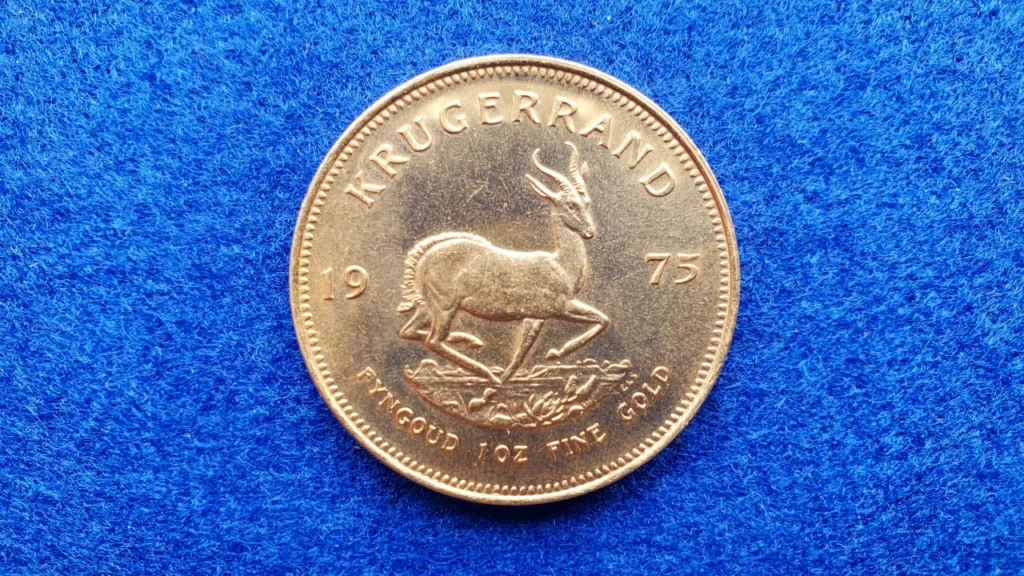
#5. 50 Pesos (Mexico)
The 50 Pesos gold coin of Mexico was first minted in 1921, on the occasion of the centenary of the independence of the country. It was initially intended as a commemorative coin, but soon gained great popularity also among investors, thanks to its high gold content. On the obverse it features the iconic figure of the Angel of Independence, with the Iztaccíhuatl and Popocatépetl volcanoes behind him. The reverse shows the national coat of arms with the eagle devouring a serpent. Despite having a nominal value, it has always been treated as an investment coin.
A peculiarity is that it contains more gold than an ounce: 37.5 grams of pure gold, making it one of the heaviest coins in circulation. Many examples bear the date “1947”, even if they were minted in later years as official re-editions. Due to its value, it is often nicknamed “centenary”.
It is known as 50 Pesos, Centenario or simply Oro Mexicano. Internationally it is often referred to by its original Spanish name.
Lesser-known alternative denominations include 20, 10, 5, 2.5 and 2 peso gold coins, but none have achieved the fame of the 50 Peso.
| Mass of Pure Gold | Diameter | Thickness |
|---|---|---|
| 37.50 g | 37 mm | 2.69 mm |
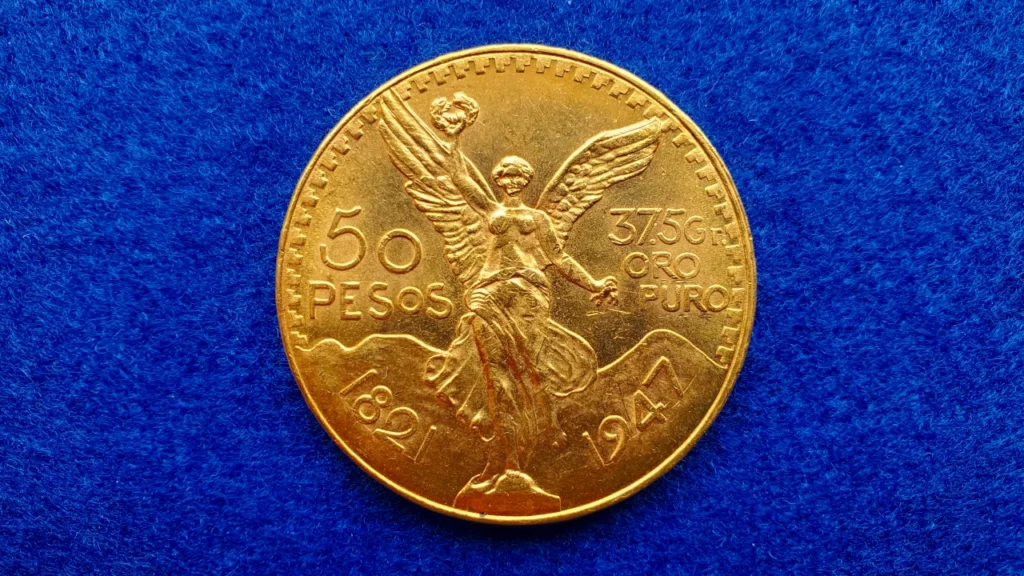
#6. Marengo (Multinational)
The Marengo was born in 1801 as a gold coin minted by the First French Republic, but became famous in the Napoleonic era, taking its name from the Battle of Marengo in 1800. It was subsequently adopted as a standard model by various European states in the nineteenth century, particularly in the monetary system of the Latin Union. The most well-known denomination is the 20 francs or lire, depending on the issuing country. In Italy, the Marengo is associated above all with the Kingdom of Sardinia and the Kingdom of Italy with the face of Vittorio Emanuele II or Umberto I. It was for a long time a coin of daily use and gold reserve.
A curiosity is that, despite the various issues from different states, the composition and weight of the Marengo remained almost identical, thanks to the agreements of the Latin Union. It is often used as a traditional gift for baptisms and communions. Today it is very popular in the investment gold market in Europe.
It is known as Marengo, although officially it can be indicated as 20 Lire, 20 Francs or 20 Crowns depending on the country. Internationally, it is also generically called “Gold 20 Francs”.
Alternative denominations include the less common half Marengo (10 Francs/Lire versions) and commemorative or collector’s variants with similar weights but modern dating.
| Mass of Pure Gold | Diameter | Thickness |
|---|---|---|
| 5.81 g | 21 mm | 1.25 mm |

#7. Maple Leaf (Canada)
The Canadian Maple Leaf was introduced in 1979 as the first bullion coin made of 99.9% pure gold, at a time when the South African Krugerrand dominated the market but was subject to trade restrictions. Canada, through the Royal Canadian Mint, thus proposed an elegant and high-purity coin, destined to become one of the most recognized in the world. The design of the famous maple leaf, the national symbol, has remained virtually unchanged since then. The obverse features a portrait of the reigning British sovereign, now King Charles III.
A special feature is that starting in 1988 the purity was increased to 99.99% and silver and platinum versions were also introduced. The Maple Leaf is also one of the first coins to adopt advanced anti-counterfeiting measures, such as laser micro-engravings and radial finishes. It is appreciated both for its beauty and for the very high quality of minting.
It is known as the Maple Leaf, Maple Leaf or even Canadian Gold. In technical circles, the English name is often used to distinguish it from imitations or commemorative versions.
Among the most popular alternative cuts are the 1/2 ounce, 1/4 ounce, 1/10 ounce, 1/20 ounce, and occasionally 1 gram versions, all of which look the same.
| Mass of Pure Gold | Diameter | Thickness |
|---|---|---|
| 31.10 g (1 ozt) | 30 mm | 2.80 mm |
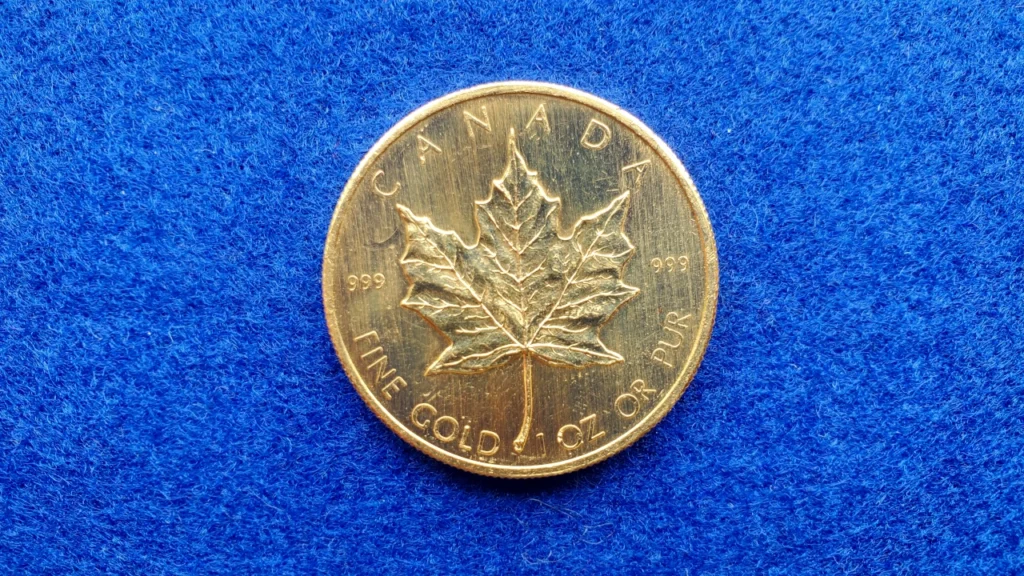
#8. Kangaroo (Australia)
The Australian Kangaroo was created in 1986 with the initial name of “Nugget” to promote Australian gold in the world, depicting famous nuggets. However, in 1989 the Perth Mint decided to adopt a new, more globally recognizable subject: the red kangaroo, the national symbol. Since then, a different design has been proposed every year, making it one of the few investment gold coins with regular graphic changes. The coin is minted in 99.99% pure gold, with a satin finish that is highly appreciated by collectors. It is recognized as legal tender in Australia.
A special feature is that the 1 tonne version of this coin, minted in 2011, is considered the largest in the world. The Perth Mint guarantees each piece for content, weight and purity, also offering platinum and silver versions. The serrated edge and the embossed details make it one of the most elegant and resistant coins.
It is known as Canguro, Australian Kangaroo or Nugget (in the first editions). In Italy it is often simply called “the Golden Kangaroo”.
Alternative denominations include 1/2 ounce, 1/4 ounce, 1/10 ounce, 1/20 ounce and even larger denominations such as 2 ounces, 10 ounces and 1 kg for collectors and institutional investors.
| Mass of Pure Gold | Diameter | Thickness |
|---|---|---|
| 31.10 g (1 ozt) | 32.1 mm | 2.80 mm |

#9. 4 Ducats (Austria)
The Austrian 4 Ducat has its roots in the period of the Habsburg Empire and is a modern reissue of a coin dating back to the 19th century. Although it bears the date 1915, almost all the examples in circulation today are official posthumous reproductions issued by the Münze Österreich. It was minted to celebrate the imperial and commercial power of Austria-Hungary, featuring the effigy of Emperor Franz Joseph I. Its classic style, high-purity gold and large diameter make it an iconic example among European coins.
A peculiarity is that, despite having a large diameter, it is a very thin and delicate coin. It is composed of almost pure gold at 98.6%, an unusual alloy compared to today’s standards. Despite the fixed date “1915”, the mint continues to produce it every year exclusively for investment and collection purposes.
It is known simply as 4 Ducats or in full as 4 Austrian Gold Ducats. It is sometimes also called Ducatone or Franz Joseph, in reference to the imperial face.
There are no equally widespread modern fractional denominations, but historically the ducat also existed in 1 and 2 ducat versions, which are much less common today.
| Mass of Pure Gold | Diameter | Thickness |
|---|---|---|
| 13.76 g | 39.5 mm | 0.8 mm |
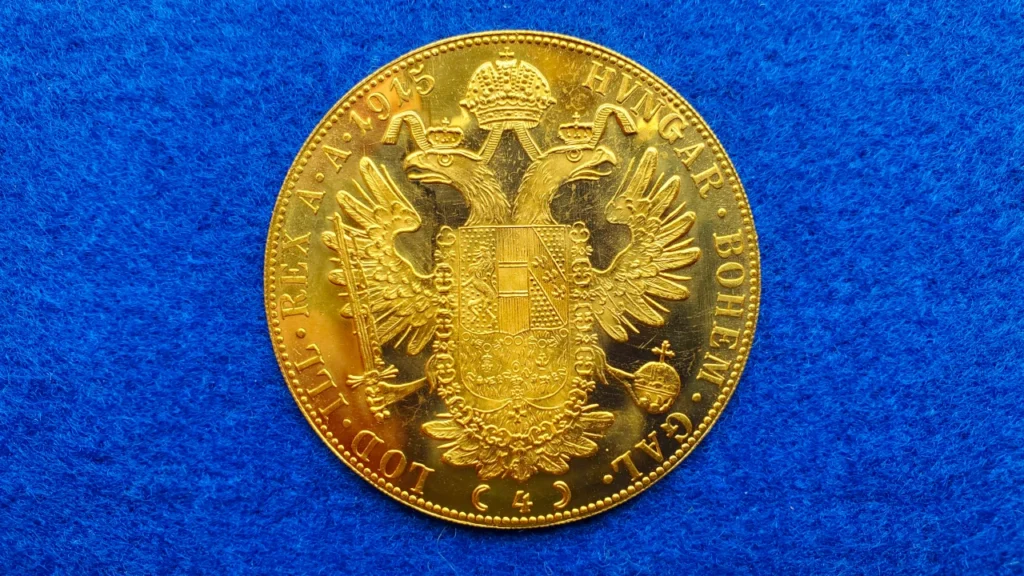

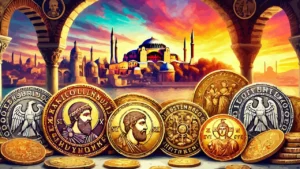









Leave a Reply